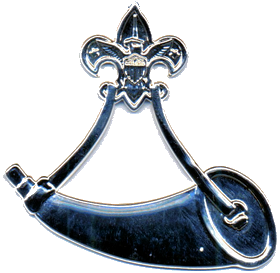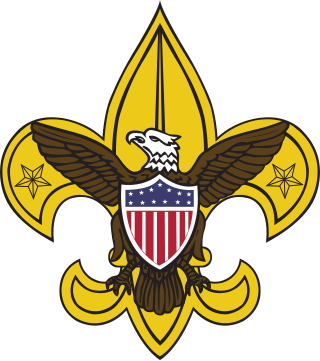
The Boy Scouts of America is one of the largest scouting organizations and one of the largest youth organizations in the United States, with over 1 million youth, including 176,000 female participants. The BSA was founded in 1910; about 130 million Americans have participated in its programs, which are served by 477,000 adult volunteers. BSA became a founding member organization of the World Organization of the Scout Movement in 1922.

Eagle Scout is the highest rank attainable in the Scouts BSA program by the Boy Scouts of America (BSA). Since its inception in 1911, only four percent of Scouts have earned this rank after a lengthy review process. The Eagle Scout rank has been earned by over 2.5 million youth.

Advancement and recognition in the Boy Scouts of America is a tradition dating from the inception of the Scouting movement. A fundamental purpose of advancement is the self-confidence a young man or woman acquires from his participation in Scouting. Advancement is one of the methods used in the "Aims and Methods of Scouting"– character development, citizenship training and personal fitness.

Cub Scouting is part of the Scouting program of Scouting America, formerly known as Boy Scouts of America (BSA), available to coeducational children from kindergarten through fifth grade, or 5 to 10 years of age and their families. Its membership is the largest of the five main BSA divisions. Cub Scouting is part of the worldwide Scouting movement and aims to promote character development, citizenship training, personal fitness, and leadership.

A variety of religious emblems programs are used by the Boy Scouts of America (BSA) to encourage youth to learn about their faith and to recognize adults who provide significant service to youth in a religious environment. These religious programs are created, administered and awarded by the various religious groups, not the BSA, but each program must be recognized by the BSA.

Venturing is a core program of the Boy Scouts of America for young men and women ages 14 through 20. It is one of the Boy Scouts' three programs for older youth, which also include Sea Scouts and Exploring. The purpose of Venturing is to provide a positive environment where youth members, called Venturers, can lead the adventure, take on new leadership roles, and mature into responsible adults.

Sea Scouts is a program of the Boy Scouts of America for young men and women ages 14 through 20.

The Boy Scouts of America (BSA) use uniforms and insignia to give a Scout visibility and create a level of identity within both the unit and the community. The uniform is used to promote equality while showing individual achievement. While all uniforms are similar in basic design, they do vary in color and detail to identify the different membership divisions of Cub Scouting, Scouts BSA, Sea Scouts, and Venturing. Many people collect BSA insignia such as camporee and jamboree emblems, council shoulder strips and historical badges.

Powder Horn was a skills resource course for Venturing and Scouts BSA leaders and youth of the Boy Scouts of America (BSA). Powder Horn is also described as a "hands-on resource management course" designed to give Scouting leaders "the contacts and tools necessary to conduct an awesome high-adventure program" in their Scouting unit. The goals of Powder Horn were to help Scout leaders safely conduct outdoor activities of a fun and challenging nature, provide an introduction to the resources necessary to successfully lead youth through a program of high adventure, and familiarize participants with the skills involved in different high adventure disciplines. The Powder Horn course would also introduce Venturing leaders to the Ranger Award program, so adults may better help Venturers in meeting the requirements. Powder Horn presented a wide variety of hands-on high adventure skills experiences and thus was not designed to provide specific skills certifications. The course is meant to be held over a one-week period or two three-day weekends. Youth attendees would get first-hand experience and information as well as resources so they could better act as Event Chairs for their units.
The history of merit badges in the Boy Scouts of America (BSA) has been tracked by categorizing them into a series of merit badge types. In addition to the Boy Scouts of America, many other Scouting and Scouting-like organizations around the world, such as Pathfinders, Baden-Powell Scouts and Royal Rangers, issue merit badges or their equivalent; though they are sometimes called honors or proficiency badges. Other organizations, such as fire brigades, issue badges or awards that they refer to as merit badges, but that is in some respects different from the badges awarded by the BSA.

Scouts BSA is the flagship program and membership level of the Boy Scouts of America (BSA) for coeducational young people between the ages of typically 11 and 17. It provides youth training in character, citizenship, personal fitness, and leadership, and aims to develop the skills necessary to become successful adults.

The Boy Scouts of America (BSA) was inspired by and modeled on The Boy Scouts Association, established by Robert Baden-Powell in Britain in 1908. In the early 1900s, several youth organizations were active, and many became part of the BSA.

The advancement program for Scouts participating in the Scouts BSA program of the Boy Scouts of America is symbolized by the earning of seven ranks. The advancement program is often considered to be divided into two phases. The first phase from joining to First Class is designed to teach the scout Scoutcraft skills, how to participate in a group and to learn self-reliance. The Scout badge is awarded when the Scout demonstrates a rudimentary knowledge of the Scouting ideals and program. Tenderfoot, Second Class, and First Class have progressively harder requirements in the areas of Scoutcraft, physical fitness, citizenship, personal growth and Scout Spirit.

Square knot insignia are embroidered cloth patches that represent awards of the Scout associations throughout the world.
The Eagle Scout Service Project, or simply Eagle Project, is the opportunity for a Scout, or qualified Venturer or Sea Scout in the Boy Scouts of America (B.S.A.) to demonstrate leadership of others while performing a project for the benefit of their community. This is the culmination of the Scout's leadership training, and it requires a significant effort on his or her part. The project must benefit an organization other than the B.S.A., and it cannot be performed for an individual or a business or be commercial in nature. Completing an Eagle Project is a requirement in order for Scouts to attain the Eagle Scout rank.
The BSA Distinguished Conservation Service Award Program is a series of awards presented by the Boy Scouts of America (BSA) for service in conservation and ecology. Created by William Temple Hornaday as the Permanent Wild Life Protection Fund Medal in 1915, the program is designed to encourage learning about natural resource conservation and the environment, teach sound stewardship of the natural resources and the environment, and recognize those who are outstanding in this field. After Hornaday's death in 1937, the program was renamed in his honor to the William T. Hornaday Awards in 1938 and officially became a BSA award program. In October 2020, after a review of Hornaday's life, the BSA changed the name of and significantly modified the program, stating that some of Hornaday's beliefs went "against the BSA’s values," and determined that "the conservation award should no longer bear his name in order to uphold our commitment against racism and discrimination."
The advancement program for the Scout Association of Japan is symbolized by the earning of several rank badges.

The Quartermaster Award is the highest rank attainable in the Sea Scouting program of the Boy Scouts of America.
The Scouter's Training Award is an adult recognition of the Boy Scouts of America. This award is available across several different program areas and can be earned more than once.

The Venturing Summit is the highest rank for youth in the Venturing program of the Boy Scouts of America. It requires Venturers to earn the Pathfinder Rank, participate in adventures, and demonstrate leadership, service and personal growth.














